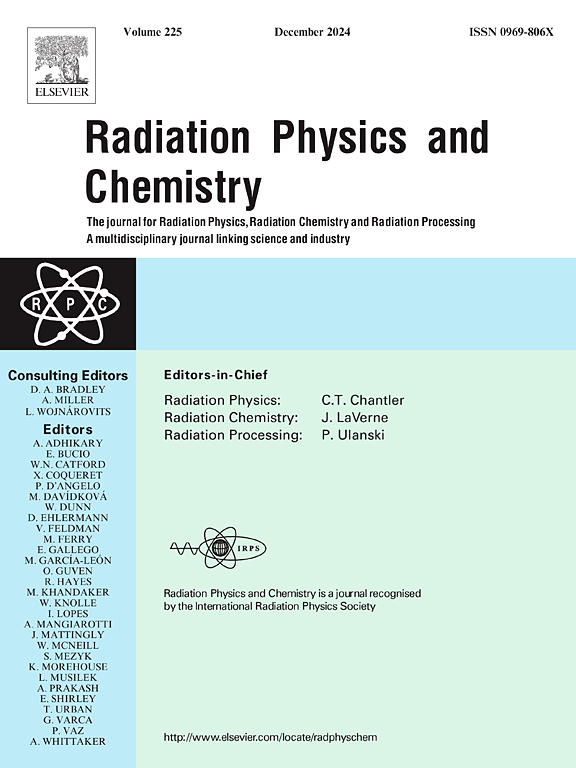NiFe2O4@SiO2 superparamagnetic nanoparticles as contrast agents in image-guided adaptive brachytherapy (IGABT)
IF 2.8
3区 物理与天体物理
Q3 CHEMISTRY, PHYSICAL
引用次数: 0
Abstract
Focusing on the study of superparamagnetic iron oxide samples for applications as contrast agents, the potential utility of NiFe2O4@SiO2 sample as a contrast agent in image guided adapted brachytherapy (IGABT) treatments is described here. This magnetic sample was prepared by controlled hydrothermal synthesis with urea addition and further TEOS reaction using the Stöber method. X-ray patterns show diffraction maxima indexed to a cubic symmetry of S. G. Fd-3m with Z = 8, compatible with an inverse spinel-type structure. Polyhedral shape particles with a size of about 21 ± 5 nm, together with a homogeneous silica coating of 12.7 ± 1 nm thickness were observed in TEM images Catheters and plastic needles containing NiFe2O4@SiO2 sample in agarose solution mixture were investigated. Images obtained by magnetic resonance imaging (MRI), computed tomography (CT) and X-ray of the ovoid applicator containing NiFe2O4@SiO2 sample in agarose solution mixture, suggest that this sample may be useful for visualizing the source path by performing a T2 weighted MRI and without the need to acquire a CT image. This process reduces uncertainties due to patient movements between imaging modalities as well as procedure time. MRI and CT images of the interstitial needles filled with this solution at different concentrations confirm that it is also suitable for use as a contrast agent. Finally, the investigated sample-agarose mixture was also inserted into a block of human-like pork tissue to approximate an “in vivo” experimentation. The results suggest that the studied sample may be useful in IGABT treatments and intraoperative BT where a series of catheters are implanted into the surgical cavity. Currently, the contrast agents used are not visible inside plastic needles. Our study shows that no toxicity is introduced into the system since the sample is contained within plastic catheters and never encounters the tissue.
将 NiFe2O4@SiO2 超顺磁性纳米粒子用作图像引导自适应近距离放射治疗(IGABT)的造影剂
本文重点研究了用作造影剂的超顺磁性氧化铁样品,介绍了 NiFe2O4@SiO2 样品作为造影剂在图像引导适应性近距离放射治疗(IGABT)中的潜在用途。这种磁性样品是通过控制水热合成法制备的,其中添加了尿素,并使用斯托伯法进一步进行了 TEOS 反应。X 射线图显示,衍射最大值为 S. G. Fd-3m 的立方对称性,Z = 8,与反尖晶石型结构相匹配。在 TEM 图像中可以观察到大小约为 21 ± 5 nm 的多面体颗粒,以及厚度为 12.7 ± 1 nm 的均匀二氧化硅涂层,并对琼脂糖溶液混合物中含有 NiFe2O4@SiO2 样品的导管和塑料针头进行了研究。通过磁共振成像 (MRI)、计算机断层扫描 (CT) 和 X 射线获得的琼脂糖溶液混合物中含有 NiFe2O4@SiO2 样品的卵形涂抹器图像表明,这种样品可用于通过执行 T2 加权磁共振成像来观察放射源路径,而无需获取 CT 图像。这一过程减少了患者在不同成像模式之间移动所造成的不确定性,同时也缩短了手术时间。用不同浓度的这种溶液填充间隙针的核磁共振成像和 CT 图像证实,它也适合用作造影剂。最后,还将所研究的样本--琼脂糖混合物植入一块类人猪肉组织中,以进行近似 "体内 "实验。研究结果表明,所研究的样品可用于 IGABT 治疗和术中 BT(将一系列导管植入手术腔)。目前,所使用的造影剂在塑料针头内是不可见的。我们的研究表明,由于样本包含在塑料导管中,从未接触到组织,因此不会对系统造成毒性。
本文章由计算机程序翻译,如有差异,请以英文原文为准。
求助全文
约1分钟内获得全文
求助全文
来源期刊

Radiation Physics and Chemistry
化学-核科学技术
CiteScore
5.60
自引率
17.20%
发文量
574
审稿时长
12 weeks
期刊介绍:
Radiation Physics and Chemistry is a multidisciplinary journal that provides a medium for publication of substantial and original papers, reviews, and short communications which focus on research and developments involving ionizing radiation in radiation physics, radiation chemistry and radiation processing.
The journal aims to publish papers with significance to an international audience, containing substantial novelty and scientific impact. The Editors reserve the rights to reject, with or without external review, papers that do not meet these criteria. This could include papers that are very similar to previous publications, only with changed target substrates, employed materials, analyzed sites and experimental methods, report results without presenting new insights and/or hypothesis testing, or do not focus on the radiation effects.
 求助内容:
求助内容: 应助结果提醒方式:
应助结果提醒方式:


